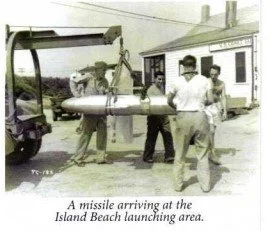
Island Beach History 101
“Island Beach is unique. It is a jewel. There is nothing like it anywhere else on earth.” -Governor Alfred E. Driscoll
Did you know that Island Beach State Park is one of the few remaining undeveloped barrier islands in the northeast but it was not always going to stay that way. Many groups have tried to lay claim to the island throughout the years for its access to the natural resources of the bay and the ocean however, none have truly succeeded.
Much of the recreational activities that drew the Baymen, fisherman and sportsmen of past still to this day draw in a majority of the Park visitors today. No matter who laid claim to this island, there was always a striving towards preserving the islands natural resources; from the deep cultural and spiritual reliance of the Lenni Lenape Native Americans, to the Freeman rules of “Leave things be. Don’t trample the sand dunes, don’t pick the flowers and don’t annoy the osprey.” And finally we get to the mission of the New Jersey Division of Parks and Forestry “We are dedicated to the excellent stewardship of the state’s rich and diverse historic, cultural, recreational and natural resources for the benefit of present and future generations.” The Island Beach Nature program furthers to support this by being interpreters of this great piece of New Jersey history, take a look at the history below to see how each group laid claim to this unique jewel.
The Lenni Lenape & the 1700’s
The Lenape Native Americans were the original inhabitants of the area known today as New Jersey and were the earliest visitors to Island Beach. While the Lenape had permanent settlements on the mainland, they also built seasonal settlements along the Jersey shore where they would hunt waterfowl and shore birds, fish, crab, clam, collect and produce wampum, gather eggs and trap turtles and muskrats. Take a more in depth look at how the Leni Lenape’s used island resources to benefit their lives in a historical lesson led by naturalists in our Nature Program.
In the 1700’s European explorers sailed west and explored the “New World.” The most detailed account of early exploration comes from the 1609 log of Henry Hudson’s log keeper on board the boat the Half Moon.
The boat’s log states about the Barnegat Inlet: “…we came to a great lake of water, as could judge it to be, being drowned land which made its rise like islands, which was in length 10 leagues. The mouth of the lake had many shoals and the sea breaks upon them as it is cast out of the mouth of it. And from that lake or bay the land lies north by east and we had a great stream out of the bay.”
The shoals are now known as Barnegat Inlet and the great lake as Barnegat Bay. He also noted that “this is a very good land to fall in with, and a pleasant land to see.” In 1635, Charles I of England gave land grants in the New World to the first Earl of Stirling. At the time, Island Beach was known as Lord Stirling’s Isle.
Baymen & Sportsmen - 1800’s
Sportmen shacks
By 1850, the newly formed Ocean County had over 10,000 residents. People traveled to the shore by stagecoach and boat. With the arrival of the railroad, many sportsmen from New York and Philadelphia began to travel to the Jersey shore for hunting and fishing. Early accommodations included primitive shacks, of which there were nearly 100 on Island Beach. Later visitors did not wish to be pioneers, however, and resort hotels began to spring up along the coast from Bay Head to Tuckerton. Two such hotels were the Reed and Haring Hotels on Island Beach. Locals acted as guides to the visitors. Gun clubs were also built in the marshes on Barnegat Bay. In addition to sport hunting, “market gunning” supplied fresh wild goose and duck to upscale city restaurants
Judges Shack
The Judge's Shack was built around 1911. Although some sources state that construction took place in 1908. Two families have been known to occupy this building - the Rickards' from 1929 until 1942 and the Hartshornes' from 1942 until 2006. Originally located among the dunes at the northern end of Island Beach, the shack was relocated to its current position in 1952 by leaseholder Richard Hartshorne and his family.
Get a glimpse of this historical landmark by hiking through either the access 12 trail or the Cranberry Trail and turning North on the beach.
Pound fishing
By 1850, the newly formed Ocean County had over 10,000 residents. It was during this time that the culture of the “Baymen” began to emerge. Early settlers to the area found they could supplement their diet and income with fish, clams and waterfowl. It wasn’t long before these baymen were able to support themselves entirely from the waters of the Barnegat Bay. They trapped muskrats, hunted shorebirds and waterfowl, harvested salt hay and eelgrass, fish for striped bass and bluefish, tonged for oysters and clams, tended lobster and eelpots, caught turtles and blue claw crabs, built boats, carved decoys, acted as guides to visiting sportsmen, sung songs and spun yarns.
Fisherman specializing in “pound” fishing also operated off Island Beach and along the coast. Impoundments, or traps, were set up off shore constructed with wood poles and fishnets. Boats were rowed from the beach and any fish caught were scooped out of the nets and rowed back, where horses would haul them onto the shore. Berkeley Fish Co., Seaside Fish Co. and Spring Lake Fish Co., all operated off Island Beach.
The Borough of Island Beach - 1900’s
Henry Phipps
In 1926, Henry Phipps, Andrew Carnegie’s partner in Pittsburgh Steel, purchased Island Beach. He envisioned Island Beach as an exclusive summer resort, and constructed three model homes. The 1929 stock market crash and the Depression that followed brought an end to his dream. When Henry Phipps died in 1930, Island Beach was left under the watchful eye of the estate foreman, Francis Freeman. In 1933 Freeman, his wife, and retired Coast guard captain, Joseph Tilton, created the Borough of Island Beach. Each assumed multiple roles: Freeman was Fire Chief, head of the Board of Education and Mayor while his wife was Borough clerk, Tax Collector, and Borough Registrar. As managers of Phipps Barnegat Bay and Beach Company they leased 100 land leases and passes to visitors, making the rules simply to be “Leave things be. Don’t trample the sand dunes, don’t pick the flowers and don’t annoy the osprey.”
Formation of Island Beach State Park
During World War II the island was evacuated and patrolled by the guard of the Coast Guard. In 1945, scientists from Johns Hopkins University tested the world’s first supersonic anti-aircraft missile at Island Beach. During a discussion about this new mission, scientists spotted a wall hanging with the saying.
The Bumblebee Cannot Fly
According to recognized aerotechnical tests, the bumblebee cannot fly because of the shape and weight of his body in relation to the total Wing area. But, the bumblebee doesn't know this so he goes ahead and flies anyway - A.S Waldrop
Realizing the mission would also encounter seemingly impossible challenges scientists dubbed it "Operation Bumblebee." “Operation Bumblebee” was a success, traveling over 9 miles at 1.5 times the speed of sound, and was the prototype for modern rocket weapons.
The same year saw the creation of the National Monument Committee, which attempted to raise money to purchase Island Beach for the National Park Service. Even with support of then President Herbert Hoover, funding could not be secured for its purchase. In 1953, the State of New Jersey purchased Island Beach for 2.7 million dollars. When Governor Driscoll accepted the deed from the Phipps’ heirs, he stated “Island Beach is unique. It is a jewel. There is nothing like it anywhere else on earth.” The park opened in 1959 under the Department of Conservation and Economic Development. It is presently operated and preserved by the Division of Parks and Forestry under the Department of Environmental Protection. Since then the Park has worked with many other partner organizations to promote and protect these precious natural land and resources.
Nature and Interpretive Centers
The nature and interpretive centers at IBSP are rich with history and culture. Built in 1855, these buildings served the US Life Saving Service as Life Saving Station #15 and Forked River Coast Guard Station #112.
These stations were constructed in response to the coast’s ever changing shoals that resulted in 200 ships being wrecked during the winter of 1826-27, helping the Jersey Coast earn the nickname “the Graveyard of the Atlantic.” In 1846, the wreck of the John Minturn became a rallying cry for preventing further loss of life due to shipwreck. As a result, $10,000.00 was attached to the existing Lighthouse Bill to create the United States Life Saving Service. Three stations were built on Island Beach. In 1915, the Life Saving Service merged with the Revenue Cutter Service to form the present day Coast Guard. Today, they house a vast collection of ecological and historical materials and displays and are home base to the IBSP Nature Program.




